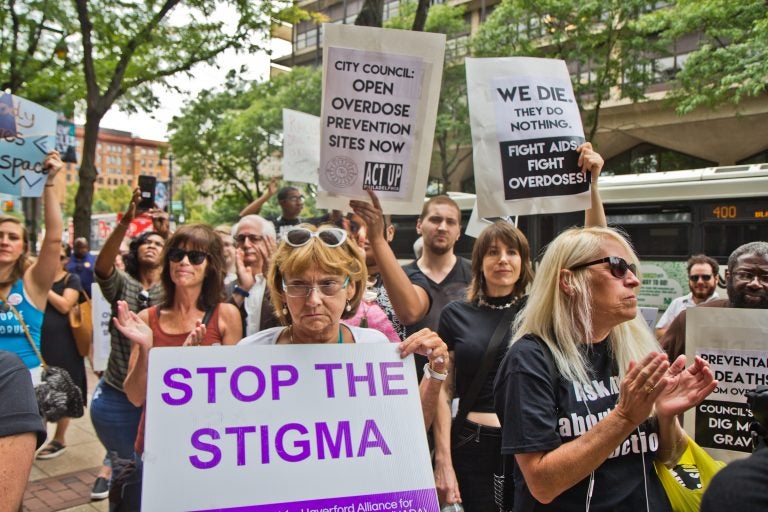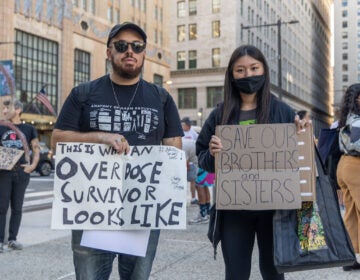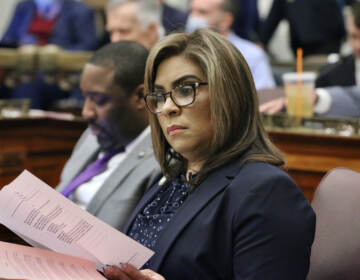Time for Safehouse to ask forgiveness, not permission, on Philly supervised injection site, experts say
Once the national leader in the charge to open a supervised injection site, the nonprofit group is mired in legal battles, with no clear path out.

File Photo: Safe injection site supporters in Philadelphia rallied outside a federal hearing to determine if the proposed Safehouse would violate the federal Controlled Substances Act. (Kimberly Paynter/WHYY)
For years, Philadelphia was poised to be the first city in the country to open a supervised injection site, where people could inject illegal drugs under medical supervision to prevent overdoses.
On Tuesday, the city lost that race to New York City.
“Being the 1st [Overdose Prevention Center] site in the US is an honor & incredible step forward in ending the opioid crisis,” tweeted OnePoint, the New York City nonprofit group established to run the site, on Tuesday morning.
Researchers who followed the effort in New York say the announcement from term-limited Mayor Bill de Blasio snuck up on them. For a long time, organizers in New York didn’t have a building secured and faced considerable roadblocks on the state level. But once Gov. Andrew Cuomo was out of office and de Blasio’s former health commissioner took the top medical post at the state level, a door opened.
“We have a new administration in Washington, a new administration in Albany,” de Blasio told reporters in October when he announced the sites would open soon. “It was the right time to do something on this topic, while we could finally have the kind of potential cooperation we need.”
Two Manhattan sites, in East Harlem and Washington Heights, opened Wednesday with blessing from the district attorney and police force.
Meanwhile in Philadelphia, Safehouse, the nonprofit group established to open the supervised injection site here, is mired in a protracted legal battle with no clear path to opening.
“NYC’s overdose prevention centers are a significant step forward in harm reduction, and we applaud all involved,” said Safehouse board vice president Ronda Goldfein. “In Philadelphia, we remain focused on legal federal authority for Safehouse and other communities that hope to offer overdose prevention.”
But it’s exactly that focus on the legal route, without building community support for the sites, that many harm reduction and legal experts agree caused Safehouse to fall behind in the race to open first.
“It was a top-down, technocratic approach which did not work,” said Leo Beletsky, a law professor at Northeastern University who has closely followed the trajectory of both cities’ fights to open the sites.
Beletsky pointed to the examples of syringe exchange, naloxone distribution, and fentanyl test strips, all harm reduction strategies that were not legally sanctioned when activists began utilizing them.
“A lot of innovation in harm reduction has really proceeded through civil disobedience in the United States,” he said. “It has not proceeded through formal legal channels.”
To a certain degree, Safehouse had no choice but to go the legal route. The Trump administration sued the nonprofit in federal court in February 2019 to prevent Safehouse from opening. Initially, a U.S. District Court judge ruled that Safehouse would not violate federal law. But then-U.S. Attorney William McSwain appealed that ruling, and a panel of Third Circuit Court of Appeals judges overturned the decision. They agreed with McSwain that such a site would violate the so-called “crack house statute” in the federal Controlled Substances Act, designed to outlaw any site that operates with drug use as its purpose.
In between the two rulings, Safehouse had a window when it could have legally opened. But it missed its chance. And that, according to Beletsky and others, has everything to do with its poor relationships with community members.
One big factor in Safehouse’s squandered attempts was squeamish landlords, who, sensitive to concerns from neighbors that the sites would increase crime or targeted drug dealing in the surrounding area, backed out of lease deals. Staffers who successfully opened sites in New York City said they solved that problem by opening the supervised injection sites within existing operations that had already been providing syringe exchange services, so that the building managers already trusted the organizations.
“A BIG reason why the [Supervised Consumption Site] worked is because it had strong support by the building’s management company, both to open the original [Syringe Services Program] and to expand to SCS later,” tweeted Brian Hackel, an overdose prevention specialist with the Washington Heights CORNER Project, one of the new New York City sites.
Safehouse, by contrast, purposely decided not to open within syringe exchange Prevention Point, to avoid putting the established organization that so many depend on at risk of being shut down by law enforcement. Hackel noted that he thought creating a brand new entity made the idea of a supervised injection site harder for area businesses and the public to swallow.
Not being able to rely on area landlords meant that instead of attempting to open in Kensington, which has the highest overdose rate in the city and where at least some of the groundwork had been laid among neighbors, Safehouse tried to open up in South Philadelphia
Neighbors there were blindsided by the plans and came out in droves to oppose them. The lack of community involvement led several City Council members to turn cool on the issue. Substantial community opposition factored into the stay granted to the U.S. attorney that prevented Safehouse from moving forward, and bolstered the arguments that ultimately helped him win on appeal.
“I think that Safehouse did not do a great job getting the political and community support,” said Scott Burris, a law professor and director of the Center for Public Health Law Research at Temple University. But, he said, you can only blame Safehouse so much for those shortcomings — it is a small organization, designed to do a very specific thing: open a supervised injection site.
If you want to win over the support of a community like Kensington, where public drug dealing and use is commonplace and city services have been lacking for decades, Burris said, you need more than an autonomous nonprofit offering an edgy solution to an isolated problem. You need a full city apparatus.
“This should be a city-run or city-sponsored and paid-for operation,” said Burris. “The city should be bringing in other services and activities that people in the community feel they need, so that you have a comprehensive response to the problems of serious open-air drug use and drug markets in that community.”
Now though, said Burris, it will be even harder for the mayor to formally support or fund the effort, since there is a Third Circuit decision on the books ruling it is against the law.
That’s one factor in why some are saying it’s time to forget the law.
While it would be illegal for Safehouse to open in Philly now, the U.S. attorney could still exercise discretion and decide not to go after the group if it opened a supervised injection site. Though the Third Circuit ruling doesn’t technically apply in New York City, the government could crack down on the sites there on the same grounds McSwain did, with precedent on its side. De Blasio is gambling that the feds will treat supervised injection sites as they do state-level cannabis sales.
As for any insight on whether that’s a good bet, the Biden administration has stopped short of expressing a clear position on supervised injection sites. But its hand may be forced soon.
After Safehouse’s appeal was denied, it requested that the case be heard by the Supreme Court. That request was denied, so the group submitted new arguments on the district court level. It is awaiting a response to its case from the Justice Department, which will signal where the Biden administration stands on the issue.
But time is ticking away, and Philadelphia is on track to have a record number of overdose deaths for 2021. When asked if Safehouse should simply open up a site in the interim, Peter Davidson, a researcher focused on harm reduction who has studied an underground supervised injection site somewhere in the United States, gave a resounding yes.
“I would really love it if Safehouse did that,” Davidson said.
Burris said he thought Safehouse might be waiting until a new Biden-appointed U.S. attorney is named in the Eastern District in place of acting Trump appointee Jennifer Arbittier Williams, who would be more likely to crack down on Safehouse if it opened now.
Meanwhile, New York City’s sites are up and running. Sites in Rhode Island are on the fast track, and other cities may soon follow suit. Burris worries that, at this rate, Philly will find itself at the end of the pack, instead of at the front.
“If saving lives through a mechanism like a safe injection site comes down to years of litigation and the most creative of legal arguments you could think of just to get it in one place, it ain’t going to do any good anyway,” he said. “It’ll be way too little, way too late.”

Get daily updates from WHYY News!
WHYY is your source for fact-based, in-depth journalism and information. As a nonprofit organization, we rely on financial support from readers like you. Please give today.







